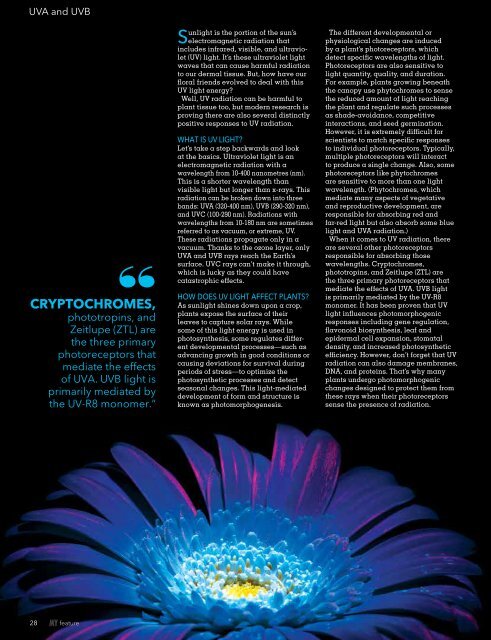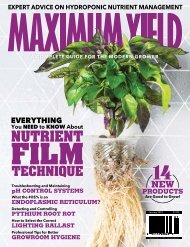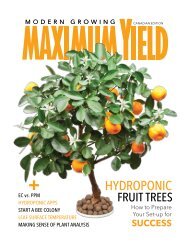Maximum Yield Modern Growing | Canadian Edition | May June 2017
In this issue of Maximum Yield, we cast a wide net to bring you the best and latest information possible to help you get started growing your own food. From the basics like cleaning your equipment to the best methods for preparing your plants to live outdoors, to more advanced topics like lighting and nutrient delivery, there is something in this issue for all levels of grower.
In this issue of Maximum Yield, we cast a wide net to bring you the best and latest information possible to help you get started growing your own food. From the basics like cleaning your equipment to the best methods for preparing your plants to live outdoors, to more advanced topics like lighting and nutrient delivery, there is something in this issue for all levels of grower.
Create successful ePaper yourself
Turn your PDF publications into a flip-book with our unique Google optimized e-Paper software.
UVA and UVB<br />
“<br />
CRYPTOCHROMES,<br />
phototropins, and<br />
Zeitlupe (ZTL) are<br />
the three primary<br />
photoreceptors that<br />
mediate the effects<br />
of UVA. UVB light is<br />
primarily mediated by<br />
the UV-R8 monomer.”<br />
Sunlight is the portion of the sun’s<br />
electromagnetic radiation that<br />
includes infrared, visible, and ultraviolet<br />
(UV) light. It’s these ultraviolet light<br />
waves that can cause harmful radiation<br />
to our dermal tissue. But, how have our<br />
floral friends evolved to deal with this<br />
UV light energy?<br />
Well, UV radiation can be harmful to<br />
plant tissue too, but modern research is<br />
proving there are also several distinctly<br />
positive responses to UV radiation.<br />
WHAT IS UV LIGHT?<br />
Let’s take a step backwards and look<br />
at the basics. Ultraviolet light is an<br />
electromagnetic radiation with a<br />
wavelength from 10-400 nanometres (nm).<br />
This is a shorter wavelength than<br />
visible light but longer than x-rays. This<br />
radiation can be broken down into three<br />
bands: UVA (320-400 nm), UVB (290-320 nm),<br />
and UVC (100-290 nm). Radiations with<br />
wavelengths from 10-180 nm are sometimes<br />
referred to as vacuum, or extreme, UV.<br />
These radiations propagate only in a<br />
vacuum. Thanks to the ozone layer, only<br />
UVA and UVB rays reach the Earth’s<br />
surface. UVC rays can’t make it through,<br />
which is lucky as they could have<br />
catastrophic effects.<br />
HOW DOES UV LIGHT AFFECT PLANTS?<br />
As sunlight shines down upon a crop,<br />
plants expose the surface of their<br />
leaves to capture solar rays. While<br />
some of this light energy is used in<br />
photosynthesis, some regulates different<br />
developmental processes—such as<br />
advancing growth in good conditions or<br />
causing deviations for survival during<br />
periods of stress—to optimize the<br />
photosynthetic processes and detect<br />
seasonal changes. This light-mediated<br />
development of form and structure is<br />
known as photomorphogenesis.<br />
The different developmental or<br />
physiological changes are induced<br />
by a plant’s photoreceptors, which<br />
detect specific wavelengths of light.<br />
Photoreceptors are also sensitive to<br />
light quantity, quality, and duration.<br />
For example, plants growing beneath<br />
the canopy use phytochromes to sense<br />
the reduced amount of light reaching<br />
the plant and regulate such processes<br />
as shade-avoidance, competitive<br />
interactions, and seed germination.<br />
However, it is extremely difficult for<br />
scientists to match specific responses<br />
to individual photoreceptors. Typically,<br />
multiple photoreceptors will interact<br />
to produce a single change. Also, some<br />
photoreceptors like phytochromes<br />
are sensitive to more than one light<br />
wavelength. (Phytochromes, which<br />
mediate many aspects of vegetative<br />
and reproductive development, are<br />
responsible for absorbing red and<br />
far-red light but also absorb some blue<br />
light and UVA radiation.)<br />
When it comes to UV radiation, there<br />
are several other photoreceptors<br />
responsible for absorbing those<br />
wavelengths. Cryptochromes,<br />
phototropins, and Zeitlupe (ZTL) are<br />
the three primary photoreceptors that<br />
mediate the effects of UVA. UVB light<br />
is primarily mediated by the UV-R8<br />
monomer. It has been proven that UV<br />
light influences photomorphogenic<br />
responses including gene regulation,<br />
flavonoid biosynthesis, leaf and<br />
epidermal cell expansion, stomatal<br />
density, and increased photosynthetic<br />
efficiency. However, don’t forget that UV<br />
radiation can also damage membranes,<br />
DNA, and proteins. That’s why many<br />
plants undergo photomorphogenic<br />
changes designed to protect them from<br />
these rays when their photoreceptors<br />
sense the presence of radiation.<br />
28 feature


















